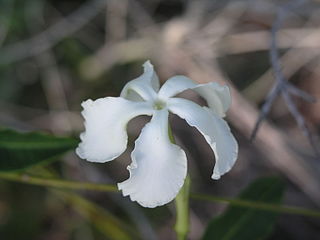| Stipecoma | |
|---|---|
 | |
| Scientific classification | |
| Kingdom: | Plantae |
| Clade: | Tracheophytes |
| Clade: | Angiosperms |
| Clade: | Eudicots |
| Clade: | Asterids |
| Order: | Gentianales |
| Family: | Apocynaceae |
| Subfamily: | Apocynoideae |
| Tribe: | Odontadenieae |
| Genus: | Stipecoma Müll.Arg. |
| Species: | S. peltigera |
| Binomial name | |
| Stipecoma peltigera (Stadelm.) Müll.Arg. | |
| Synonyms [1] | |
| |
Stipecoma is a genus of flowering plants in the family Apocynaceae, first described as a genus in 1860. It contains only one known species, Stipecoma peltigera, native to Brazil and Bolivia. [1] [2] [3]
- formerly included in the genus [1]
- Stipecoma macrocalyx(Müll.Arg.) Miers = Peltastes macrocalyx (Müll.Arg.) Woodson
- Stipecoma mucronataMiers = Peltastes peltatus (Vell.) Woodson
- Stipecoma ovataMiers = Peltastes peltatus (Vell.) Woodson
- Stipecoma parabolicaMiers = Peltastes peltatus (Vell.) Woodson
- Stipecoma peltata(Vell.) Miers = Peltastes peltatus (Vell.) Woodson
- Stipecoma plicata(A.DC.) Miers = Peltastes peltatus (Vell.) Woodson
- Stipecoma pulchraMiers = Peltastes pulcher (Miers) J.F.Morales
- Stipecoma speciosaMiers = Peltastes peltatus (Vell.) Woodson












